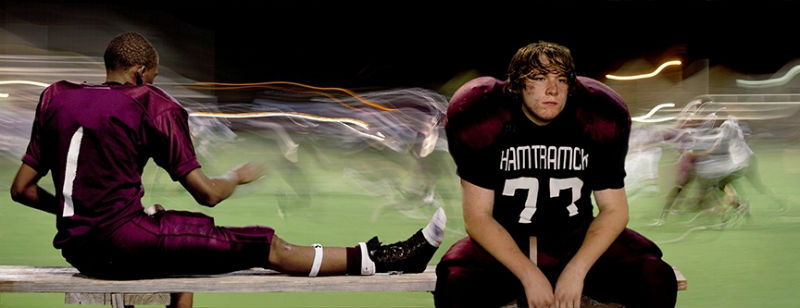Everyday Objects: "Text/Image" at Ann Arbor Art Center

We live in a hyper-literate age of endless imagery and short attention spans.
We seldom pause -- and really, when do we have time? -- to consider the process by which we create meaning for ourselves from the constant interaction of words and pictures in books, magazines, on television and the web, on our phones.
In Text/Image now on view until June 3 in Ann Arbor Art Center’s Gallery 117, Detroit-based artist/curator Jack O. Summers has thoughtfully collected for our consideration some artworks that refer to everyday objects whose meanings “are enhanced or subverted by the multi-dimensional interplay of text and images.” The exhibit concentrates on still imagery, leaving aside the more kinetic treatments of text and image interaction such as video and animation.
There are several artists represented in Text/Image who are well known in Detroit for their absurdist take on the news and pop culture, using the vocabulary of comics and newspapers to communicate their points of view. Ryan Standfest, gifted printmaker, founder of the Rotland Press and trickster artist, composes headlines for his imaginary tabloid newspaper the Modern Vulgarian (#1) that raise more questions than they answer and classified ads that go gleefully off the rails.

William Schudlich, illustrator and self-proclaimed “social zoologist,” is clearly a kindred spirit. Schudlich’s images employ the visual vocabulary of disposable print media such as comic strips and have the look of early- to mid-20th-century comics. He approaches visual challenges, he says, “with a dark sense of humor whenever possible.” Tom Carey’s large relief prints, while ostensibly mining the same classic content as Schudlich and Standfest, project a more modern effect with their vivid colors and lively compositions. The small wooden mutoscopes (flipbooks in wooden boxes operated by pushbutton) created by Andy Malone also fit comfortably with the sensibilities of Schudlich and Standfest by appropriating of a vintage craft and repurposing it to make a modern statement.
Two notable Detroit photographers, Christopher Schneider and Bruce Giffen, appear in Text/Image. In Schneider’s Underdog, the word “Hamtramck” printed on the young football player’s jersey adds context and pathos to the inward-looking figure, isolated as his teammate looks away toward the light and movement of the game. His fellow photographer Bruce Giffen, whose sharp and poetic eye is trained on Detroit at all times and in all seasons, juxtaposes text with context for special resonance in his photo Stay in School.
Taurus Burns, Dencel Deneau, Jaye Schlesinger, and Amy Fell all engage in the reification of the ordinary, each one observing with care and archiving with skill the unglamorous objects and often unsightly minutiae of the urban landscape. Deneau’s small glass mosaics, in particular, are improbably lovely memorials to fleeting moments in the life of a city.
Moving from the grittily observational to the poetic, Scott Northrup’s gauzy collages are cinematic and nostalgia-soaked. Self-Portrait With Fruit by John Gutoskey is somehow both cheerful and sad, and recalls the innocence and the pain of a young boy growing up gay in the Midwest. Like Gutoskey’s quasi-installation, Believers by Catherine Peet hardly needs text to make its point, harking back to medieval altars of a pre-literate age.
Before the printing press and universal literacy, the visual impact of letters was as important as the narrative meaning. Randy Asplund creates contemporary works using the same methods as medieval illuminators; the pigments, grounds, text and image are all carefully chosen for their symbolic resonance, each re-enforcing the meaning of the other elements. Taking the opposite tack, Alvey Jones subverts the meaning of text in Language Text and Circuit Board. Each element of the artwork is designed to be unintelligible -- the book is (literally) Greek to us, the circuit board holds its meaning in a code we are unable to penetrate.
Barbara Brown, eminent Ann Arbor book artist and curator of a yearly survey of all things art and book-related, entitled Beyond Words, here uses her collection of handmade building blocks, Metropolis, to think playfully about the way reordering words or letters can alter narrative.
Text/Image can be understood best as a survey featuring a cast of accomplished artists, any one of whom could fill the gallery with well-crafted and well-thought-out work. The art in this exhibit thoughtfully uses language and image together to address a variety of themes from autobiography to social commentary, and while curator Jack O. Summers has put together an interesting and beautiful exhibit, the subject is far from exhausted and possibly never can be.
K.A. Letts is an artist and art blogger. She has shown her work regionally and nationally and in 2015 won the Toledo Federation of Art Societies Purchase Award while participating in the TAAE95 Exhibit at the Toledo Museum of Art. You can find more of her work at RustbeltArts.com.
"Text/Image" is at the Ann Arbor Art Center’s Gallery 117, 117 W. Liberty St., through June 3. For more information, go here. This review was originally published on RustbeltArts.com.


































